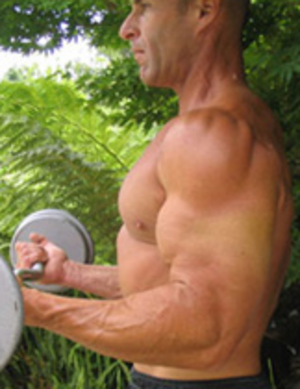(please consult a physician before beginning any sort of exercise program such as the one listed below)
Bathing suit season is near and you don’t want to be caught looking flabby – do you? Then, it is time to get up and start working out. But you want to get into great shape fast right? Well, I have your answer and it is called “Circuit Training”.
Circuit Training is when you do single sets of multiple strength training exercises with little to no rest between exercises (1). The benefits of this style of training are numerous. Because of the short or non existent rest periods trainees experience enhanced aerobic benefits in addition to the benefits of strength training(1,2). This type of training also enhances the production of testosterone and Human Growth Hormone (1, 2, 3). These two hormones are vital in maintaining a lower body fat percentage, greater muscle growth, improved brain function, improving the look of hair, skin, and nails, and improved organ function (3,4). Ladies, don’t worry about the increased levels of muscle growth. Women will not be able to build enough muscle naturally to cause them to no longer look feminine – only enough to keep the fat away.
So, if your ready to get started, check out this quick dumbbell circuit training routine:
The Routine –
You’ll need a set of dumbbells for this circuit. Choose heavier weights for this circuit to improve its effectiveness. Men will want to choose dumbbells somewhere in the 20lbs – 40lbs range. Ladies may want to start in the 10-20 lbs range. Standard protocol is to perform a set of each exercise in the circuit, completing 8-20 reps for each exercise (depending on your goals). You are allowed to rest 30 seconds or less of rest between exercises. You can also rest 30 seconds or less between each circuit. Attempt to complete 3-5 circuits in this fashion.
Exercises-
1. Dumbbell Squat: Stand with your feet a bit wider than shoulder width apart. Grasp the dumbbells and let them hang by your sides. Fold at the hips and squat down making sure to stick your butt out as though your are sitting down in a chair. Pay special attention that you do not allow your knees to protrude beyond you toes and that you keep your weight on your heels. Once your thighs are parallel (or just a bit lower) to the floor stand back up.
2. Standing Shoulder Press – Bring the dumbbells up to just above shoulder height on each side of your head, elbows pointing down, and palms facing inward towards your head. Press both dumbbells up overhead making sure that you don’t over-arch your lower back. Just before you reach full lockout, reverse the movement and bring them back to the starting position.
3. Bent Over Row – Start by standing up with feet shoulder width apart and knees slight bent. Grab the dumbbells and allow them to rest on your upper thighs. Bend over by folding at the hips. This will cause the dumbbells to hang under your upper body. Make sure to stick your chest out. Now, simply pull the dumbbells up towards your chest. Make sure you keep them about shoulder’s width apart. Think of the movement more as though you are pulling your elbows back and squeezing your shoulder blades together. This should help you recruit the correct muscles.
4. Deadlift – Start by standing up with feet hip width apart and knees slight bent. Grab the dumbbells and allow them to rest on your upper thighs. Now, fold at the hips, stick your butt back, and bend your knees. This will cause the dumbbells in your hands to travel towards your feet. Once you have bent down enough for the dumbbells to reach mid-shin reverse the movement and stand back up. Make sure that you stick your chest out throughout the movement.
5. Hammer Curls – Start by standing up with the back straight and your chest out. Dumbbells are in your hands and hanging naturally at your sides. Your palms are facing in towards your body. Now simply curl the dumbbells up towards your shoulders until your lower arms and upper arms form 30 degree angles. Once you reach the top of the lift reverse the movement back to the starting position. Make sure you keep your wrists in the same neutral position that they started in as you complete this movement.
6. French Press – While standing bring the dumbbells up and behind your shoulders with your elbows pointing up towards the ceiling. Your upper arm and lower arm with form a 90 degree angle. While keeping your upper arms stationary, press the dumbbells over head as though you are making a hammering type motion with both weights. Bring the dumbbells back down and do not allow your lower arms to dip past 90 degrees in relation to your upper arms.
Try this routine 3 days a week giving yourself a day of rest in between each training session. On your days off you can opt to do some form of cardiovascular training. You can use the typical prescription for long slow cardio (30-60 at a moderate pace) or you can really ramp up your results and try your hand at interval training. While on your cardio equipment of your choice, alternate timed rest and work intervals. One minute of working at a hard and face pace, followed by one minute working at an easy to moderate pace for 10-20 (not including warm up) should be sufficient.
Have Fun and Train Hard.
Sources:
- Bayer, Jeff. “circuit Training: What Can it Do for You?” 2009. http://www.askmen.com/sports/bodybuilding_100/131fitness_tip.html
- Clapis, Phyllis PT. DHSc OCS. “Circuit Training” 2005. http://www.med.umich.edu/1libr/sma/sma_circuit_sma.htm
- Burton, Ray. “Human Growth Horomone Research Important for Fitness.” 2008. http://www.buildingbodies.ca/nutrition/Growth_horomone.shtml
- Performance, Peak. “The Testosterone Effect” 1994. http://www.pponline.co.uk/encyc/0308.htm



